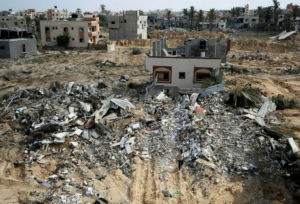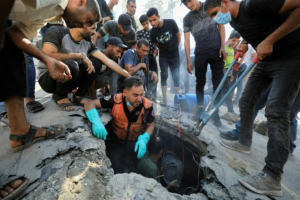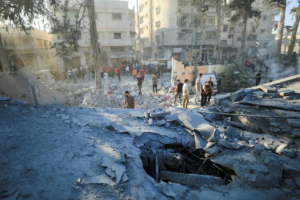Why Hamas tries to hide the number of its militants killed by Israel

The damage after Israeli forces withdrew from Khan Younis, Southern Gaza, following a ground operation, 30 August 2024
Sheren Falah Saab writes in Haaretz on 4 September 2024:
The video posted by Hamas began to appear on social media in early July. Two armed men from the group’s military wing, faces blurred, warned: “We’re preparing to meet the enemy” in the Gaza Strip. A short time later, the identity of one of them was revealed, after IDF forces killed him in Shujaiyeh: Abed al-Sakr Abu Hin. His mother eulogized him in a short – and extremely exceptional – video.
Hamas avoids releasing information about those killed among its military wing. In contrast, Hezbollah, has for years released pictures of its dead militants, whom the group’s leader also mentioned in his speeches.
This contrast has stood out in particular since October 7, with the release of long lists of names of women, children and elderly people killed during the war. According to official figures published by Hamas on Monday, the latest number of casualties is 40,786 dead and 94,224 injured. The numbers don’t differentiate between civilians and combatants. The IDF notes a number of additional problems with the data released by the Hamas-run Health Ministry in Gaza. For one, verifying many of the casualties is impossible. According to the army, several well-known senior terrorists have been list as women, or they appeared among the dead with fake ID numbers. Nonetheless, human rights organizations say the data released by Hamas are credible and may even be an underestimate.
For Gaza residents, the censorship of the identity of the dead Hamas members has created a complex situation, with clear unwritten rules. Several of them have told Haaretz that the enormous fear of these rules make their enforcement unnecessary.

Palestinians inspect a school which was sheltering displaced people for victims after it was hit by an Israeli strike, Gaza City, 1 September 2024
“There is fear of speaking in public about Hamas members, even ones who were killed, for many reasons,” said Assam (a pseudonym, as are the names of all the interviewees in this article). He is 38, from Khan Yunis and left the Gaza Strip for Egypt in November. His main reason was the “fear of being seen as collaborators” and a fear of harassment by Hamas, he said.
Assam confirms that the unofficial code of silence has grown much more powerful since the war broke out. Hamas expects a total lack of criticism from locals, considering it to be “treason” that would serve the Israeli security forces. People pass on information about the deaths mostly by word of mouth. “Hamas releases the names of the organization’s dead” only in rarest of cases, he said. “The population doesn’t post them, not even the families.”
‘Today, the people are against Hamas, so the group doesn’t want to create a situation in which the public will believe the Israeli side, which says ‘we killed thousands of Hamas terrorists.”
“It’s part of the propaganda targeting Gazans,” social activist Gershon Baskin told Haaretz. Baskin mediated between Israel and Hamas in the Gilad Shalit deal. “Today, the people are against Hamas, so the group doesn’t want to create a situation in which the public will believe the Israeli side, which says ‘we killed thousands of Hamas terrorists.’ They don’t want to admit they’re collapsing militarily. Hamas announces every day they are killing Israeli soldiers, and it’s not true. Every day they brag they killed here and fired there. They want to sell to their people that they’re winning, so they won’t say how many dead there are on their side,” Baskin added.
A war over images
Similar to many other Gazans, Adnan, 43, was forced to leave Gaza City for Deir al-Balah. He told Haaretz of the great suffering the war has caused Gazan residents, and the political and public relations maneuvers by Hamas. The ban on publishing the names of the dead Hamas combatants is an important part of this maneuvering. “The common assumption on the street is that if they publish the names of dead militants, the world will identify less with the Gazans’ suffering,” Adnan said. “That will legitimize bombing Gaza. As long as there are videos and stories about the civilian population, no one says anything. But if someone dares criticize Hamas or mentions the name of a dead militant, they’ll call him a “‘traitor’ and treat him that way.”
‘The common assumption on the street is that if they publish the names of dead militants, the world will identify less with the Gazans’ suffering.’
Because of the concrete threat, the civilian population has no choice and is forced to obey, he said. “This is a wartime situation and the public really is suffering,” he said. “It’s very difficult for many, many people. They need support and aid. No one desires getting in trouble with Hamas.”
Nadia, 34 from Khan Yunis, was also uprooted from her home. She moved first to Rafah and then in December to Egypt. She mentions the official announcements from Hamas about the dead among its members. She says these mostly concern senior officials or those with important jobs, mostly in civilian affairs.

Palestinians inspect a school which was sheltering displaced people after it was hit by an Israeli strike, Gaza City, 1 September 2024
For example, Hamas released in July an official statement on the death in an Israeli attack of Ihab al-Rasin, the deputy employment minister and the former Interior Ministry spokesman in Gaza. In March, Hamas released an announcement concerning two people killed: Nadal Sheikh Eid, the chairman of the emergency committee in Rafah, and Mahmoud Abu Hasanah, the deputy deputy of police operations. “They release only the names of activists who aren’t directly involved in the fighting and whose activities focus on humanitarian matters,” she said.
It’s also hard to ignore the sharp contrast to the operations of the Hamas military wing in the West Bank. That group releases on its official Telegram channel reports on its members killed since October 7, with their full names and pictures, says Nadia. “But you won’t see a single picture of a Hamas militant from Gaza. It’s a war of survival over the image Hamas projects to the world, too. When you don’t talk about armed men, don’t mention them, don’t mention their being killed – they don’t exist in the dialogue,” she said.
Baskin agrees with Nadia. The fogginess allows Hamas to preserve its image “as a resistance movement that the entire people belongs to.” This enables the broader public to join the effort: “Every bereaved family, which is basically everyone, every family that lost its home – everyone is a potential recruit. Hamas is nearly the sole source of money in Gaza today. They pay about $300 a month for new recruits. It’s more money that what these young men have ever seen in their lives,” said Baskin.
There is another answer for the silence, too. It helps Hamas ensure complete cooperation by civilians: the fear of Israeli security forces. Bushra, 42, moved to an improvised tent made out of plastic sheets in Deir al-Balah after her Gaza City home was destroyed in an IDF attack. “There’s a real fear the army will harass them and harm other family members who aren’t involved, said Bushra. “It scares the families more than anything else.”
She said the fear is so great that “sometimes relatives who aren’t involved themselves don’t know their relatives died. She added: “The situation is so murky that family members often join the Hamas military wing without their parents’ knowledge. They learn of their death only through rumors. The families are uprooted and move from place to place. Their children who are Hamas members leave home without leaving a message as to their whereabouts. The report that they were killed travels via word of mouth until it reaches the parents.”
Assam from Khan Yunis says there are exceptional cases in which releasing the names of the militants benefits Hamas. In such cases, Hamas reveals the details “only at a time appropriate for itself,” said Assam. He gives an example of the release of names and pictures of militants who participated in the abduction of Gilad Shalit in 2006. “It happened just in December 2015 – four years after the swap between Israel and Hamas,” he said.
Hamas’ Iz al-Din al-Qassam Brigades released these pictures after Mohammed Deif allowed it, according to Al Jazeera. Shalit could be seen in one of them next to Abd al-Rahman al-Mabasher, who was in command of the “Shadow” unit guarding Shalit. Al-Mabasher was killed a few days before the picture was released as a result of a tunnel collapse, Hamas stated. Deif allowed publication of new information on the unit’s role in the abduction operation to glorify its ability to preserve secrecy and hide the location where Shalit was held.
The code: Advancing and not retreating
Throughout history, people living under dictatorial regimes with strict censorship laws have known how to trade information using a complex system of social codes. 2024 is not unusual in this way either. Gazans described to Haaretz how they and their friends manage to identify the killing of combatants amid the stream of news concerning dead civilians. The code uses a phrase in Arabic that translates as “advancing not retreating.”
For the reader who does not speak Arabic, this sentence may not seem to have special significance. Those in the know recognize it as being from the Hadith – the Islamic oral tradition in which it appears in the context of Jihad. “A man asks the messenger of God: ‘Do you think that if I am killed for Allah, my sins will be forgiven?’ The messenger answers: ‘Yes. If you are killed for Allah, as long as you are patient and content, advancing and not retreating,” explains Assam.
Nadia agrees. “Sometimes I go over the messages posted among Gazans on social media or in WhatsApp groups. And the minute they write this phrase, I understand that he is a militant.”
“It’s a small detail, but known to everyone,” said Assam. Attacking characterizes the armed militants, in other words, they were not killed by bombs, shooting or disease, but they died while advancing, during the fighting, he said. “This is how the death of the militants is described in battle. It’s common in all wars and not just now. This is what they wrote on the gravestones of the Hamas militants who were killed in the previous wars,” said Assam.
This article is reproduced in its entirety
